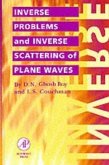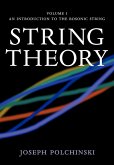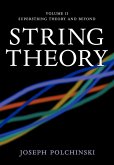Walter Fox Smith (Professor of Physics, Professor of Physics, Haver
Waves and Oscillations
A Prelude to Quantum Mechanics
Walter Fox Smith (Professor of Physics, Professor of Physics, Haver
Waves and Oscillations
A Prelude to Quantum Mechanics
- Gebundenes Buch
- Merkliste
- Auf die Merkliste
- Bewerten Bewerten
- Teilen
- Produkt teilen
- Produkterinnerung
- Produkterinnerung
This lively textbook differs from others on the subject by its usefulness as a conceptual and mathematical preparation for the study of quantum mechanics, by its emphasis on a variety of learning tools aimed at fostering the student's self-awareness of learning, and by its frequent connections to current research.
Andere Kunden interessierten sich auch für
![Introduction to Traveling Waves Introduction to Traveling Waves]() Anna R. GhazaryanIntroduction to Traveling Waves101,99 €
Anna R. GhazaryanIntroduction to Traveling Waves101,99 €![Physics of Sound Waves Physics of Sound Waves]() Panos Photinos (USA University of Southern Oregon)Physics of Sound Waves47,99 €
Panos Photinos (USA University of Southern Oregon)Physics of Sound Waves47,99 €![Inverse Problems and Inverse Scattering of Plane Waves Inverse Problems and Inverse Scattering of Plane Waves]() D.N. RoyInverse Problems and Inverse Scattering of Plane Waves68,99 €
D.N. RoyInverse Problems and Inverse Scattering of Plane Waves68,99 €![NUMERICAL MODELING OF WATER WAVES IN COASTAL & OCEAN ENGINEE NUMERICAL MODELING OF WATER WAVES IN COASTAL & OCEAN ENGINEE]() Pablo Higuera (Singapore Nus & New Zea The University Of AucklandNUMERICAL MODELING OF WATER WAVES IN COASTAL & OCEAN ENGINEE81,99 €
Pablo Higuera (Singapore Nus & New Zea The University Of AucklandNUMERICAL MODELING OF WATER WAVES IN COASTAL & OCEAN ENGINEE81,99 €![Sounds Wild and Broken Sounds Wild and Broken]() David George HaskellSounds Wild and Broken12,61 €
David George HaskellSounds Wild and Broken12,61 €![String Theory, Volume 1 String Theory, Volume 1]() Joseph Polchinski (Santa Barbara University of California)String Theory, Volume 181,99 €
Joseph Polchinski (Santa Barbara University of California)String Theory, Volume 181,99 €![String Theory, Volume 2 String Theory, Volume 2]() Joseph Polchinski (Santa Barbara University of California)String Theory, Volume 292,99 €
Joseph Polchinski (Santa Barbara University of California)String Theory, Volume 292,99 €-
-
-
This lively textbook differs from others on the subject by its usefulness as a conceptual and mathematical preparation for the study of quantum mechanics, by its emphasis on a variety of learning tools aimed at fostering the student's self-awareness of learning, and by its frequent connections to current research.
Produktdetails
- Produktdetails
- Verlag: Oxford University Press Inc
- Seitenzahl: 416
- Erscheinungstermin: 1. Mai 2010
- Englisch
- Abmessung: 260mm x 183mm x 27mm
- Gewicht: 916g
- ISBN-13: 9780195393491
- ISBN-10: 019539349X
- Artikelnr.: 29932683
- Herstellerkennzeichnung
- Libri GmbH
- Europaallee 1
- 36244 Bad Hersfeld
- gpsr@libri.de
- Verlag: Oxford University Press Inc
- Seitenzahl: 416
- Erscheinungstermin: 1. Mai 2010
- Englisch
- Abmessung: 260mm x 183mm x 27mm
- Gewicht: 916g
- ISBN-13: 9780195393491
- ISBN-10: 019539349X
- Artikelnr.: 29932683
- Herstellerkennzeichnung
- Libri GmbH
- Europaallee 1
- 36244 Bad Hersfeld
- gpsr@libri.de
Walter Fox Smith combines his passions for teaching and nanophysics research at Haverford College. His research centers on the photoelectronic properties of self-assembling molecular electronics. He is also known as "the singing physics professor", thanks to his compositions and performances in the classroom and at social gatherings of physicists.
* Learning tools used in this book
* 1.: Simple Harmonic Motion
* 1.1 Sinusoidal Oscillations are Everywhere
* 1.2 The physics and mathematics behind simple harmonic motion
* 1.3 Important parameters and adjustable constant of simple harmonic
motion
* 1.4 Mass on a spring
* 1.5 Electrical oscillators
* 1.6 Review of Taylor Series Approximations
* 1.7 Euler's equation
* 1.8 Review of complex numbers
* 1.9 Complex exponential notation for oscillatory motion
* 1.10 The complex representation for AC circuits
* 1.11 Another important complex function: The quantum mechanical
wavefunction
* 1.12 Pure sinusoidal oscillations and uncertainty principles
* Concept and skill inventory
* Problems
* 2.: Examples of Simple Harmonic Motion
* 2.1 Requirements for harmonic oscillation
* 2.2 Pendulums
* 2.3 Elastic deformations and Young's modulus
* 2.4 Shear
* 2.5 Torsion and Torsional Oscillators
* 2.6 Bending and Cantilevers
* Concept and skill inventory
* Problems
* 3.: Damped oscillations
* 3.1 Damped mechanical oscillators
* 3.2 Damped electrical oscillators
* 3.3 Exponential decay of energy
* 3.4 The Quality Factor
* 3.5 Underdamped, overdamped, and critically damped behavior
* 3.6 Types of damping
* Concept and skill inventory
* Problems
* 4.: Driven Oscillations and Resonance
* 4.1 Resonance
* 4.2 Effects of damping
* 4.3 Energy flow
* 4.4 Linear differential equations, the superposition principle for
driven systems, and the response to multiple drive forces
* 4.5 Transients
* 4.6 Electrical resonance
* 4.7 Other examples of resonance: MRI and other spectroscopies
* 4.8 Non-linear oscillators and chaos
* Concept and skill inventory
* Problems
* 5.: Symmetric coupled oscillators and Hilbert space
* 5.1 Beats: An aside?
* 5.2 Two symmetric coupled oscillators: equations of motion
* 5.3 Normal modes
* 5.4 Superposing normal modes
* 5.5 Normal mode analysis, and normal modes as an alternate
description of reality
* 5.6 Hilbert Space and bra-ket notation
* 5.7 The analogy between coupled oscillators and molecular energy
levels
* 5.8 Non-zero initial velocities
* 5.9 Damped, driven coupled oscillators
* Concept and skill inventory
* Problems
* 6.: Asymmetric coupled oscillators and the eigenvalue equation
* 6.1 Matrix math
* 6.2 Equations of motion and the eigenvalue equation
* 6.3 Procedure for solving the eigenvalue equation
* 6.4 Systems with more than two objects
* 6.5 Normal mode analysis for mulit-object, asymmetrical systems
* 6.6 More matrix math
* 6.7 Orthogonality of normal modes, normal mode coordinates,
degeneracy, and scaling of Hilbert space for unequal masses
* Concept and skill inventory
* Problems
* 7.: String theory
* 7.1 The beaded string
* 7.2 Standing wave guess: Boundary conditions quantize the allowed
frequencies
* 7.3 The highest possible frequency; connection to waves in a
crystalline solid
* 7.4 Normal mode analysis for the beaded string
* 7.5 Longitudinal oscillations
* 7.6 The continuous string
* 7.7 Normal mode analysis for continuous systems
* 7.8 k-space
* Concept and skill inventory
* Problems
* 8.: Fourier analysis
* 8.1 Introduction
* 8.2 The Fourier Expansion
* 8.3 Expansions using non-normalized orthogonal basis functions
* 8.4 Finding the coefficients in the Fourier expansion
* 8.5 Fourier Transforms and the meaning of negative frequency
* 8.6 The Discrete Fourier Transform (DFT)
* 8.7 Some applications of Fourier analysis
* Concept and skill inventory
* Problems
* 9.: Traveling waves
* 9.1 Introduction
* 9.2 The Wave Equation
* 9.3 Traveling sinusoidal waves
* 9.4 The Superposition Principle for traveling waves
* 9.5 Electromagnetic waves in vacuum
* 9.6 Electromagnetic waves in matter
* 9.7 Waves on transmission lines
* 9.8 Sound Waves
* 9.9 Musical Instruments based on tubes
* 9.10 Power carried by rope and electromagnetic waves; RMS amplitudes
* 9.11 Intensity of sound waves; decibels
* 9.12 Dispersion relations and group velocity
* Concept and skill inventory
* Problems
* 10.: Waves at interfaces
* 10.1 Reflections and the idea of boundary conditions
* 10.2 Transmitted waves
* 10.3 Characteristic impedances for mechanical systems
* 10.4 "Universal" expressions for transmission and reflection
* 10.5 Reflected and transmitted waves for transmission lines
* 10.6 Reflection and transmission for electromagnetic waves in matter:
normal incidence
* 10.7 Reflection and transmission for sound waves, and summary of
isomorphisms
* 10.8 Snell's Law
* 10.9 Total Internal Reflection and evanescent waves
* Concept and skill inventory
* Problems
* Appendix A: Group velocity for an arbitrary envelope function
* Index
* 1.: Simple Harmonic Motion
* 1.1 Sinusoidal Oscillations are Everywhere
* 1.2 The physics and mathematics behind simple harmonic motion
* 1.3 Important parameters and adjustable constant of simple harmonic
motion
* 1.4 Mass on a spring
* 1.5 Electrical oscillators
* 1.6 Review of Taylor Series Approximations
* 1.7 Euler's equation
* 1.8 Review of complex numbers
* 1.9 Complex exponential notation for oscillatory motion
* 1.10 The complex representation for AC circuits
* 1.11 Another important complex function: The quantum mechanical
wavefunction
* 1.12 Pure sinusoidal oscillations and uncertainty principles
* Concept and skill inventory
* Problems
* 2.: Examples of Simple Harmonic Motion
* 2.1 Requirements for harmonic oscillation
* 2.2 Pendulums
* 2.3 Elastic deformations and Young's modulus
* 2.4 Shear
* 2.5 Torsion and Torsional Oscillators
* 2.6 Bending and Cantilevers
* Concept and skill inventory
* Problems
* 3.: Damped oscillations
* 3.1 Damped mechanical oscillators
* 3.2 Damped electrical oscillators
* 3.3 Exponential decay of energy
* 3.4 The Quality Factor
* 3.5 Underdamped, overdamped, and critically damped behavior
* 3.6 Types of damping
* Concept and skill inventory
* Problems
* 4.: Driven Oscillations and Resonance
* 4.1 Resonance
* 4.2 Effects of damping
* 4.3 Energy flow
* 4.4 Linear differential equations, the superposition principle for
driven systems, and the response to multiple drive forces
* 4.5 Transients
* 4.6 Electrical resonance
* 4.7 Other examples of resonance: MRI and other spectroscopies
* 4.8 Non-linear oscillators and chaos
* Concept and skill inventory
* Problems
* 5.: Symmetric coupled oscillators and Hilbert space
* 5.1 Beats: An aside?
* 5.2 Two symmetric coupled oscillators: equations of motion
* 5.3 Normal modes
* 5.4 Superposing normal modes
* 5.5 Normal mode analysis, and normal modes as an alternate
description of reality
* 5.6 Hilbert Space and bra-ket notation
* 5.7 The analogy between coupled oscillators and molecular energy
levels
* 5.8 Non-zero initial velocities
* 5.9 Damped, driven coupled oscillators
* Concept and skill inventory
* Problems
* 6.: Asymmetric coupled oscillators and the eigenvalue equation
* 6.1 Matrix math
* 6.2 Equations of motion and the eigenvalue equation
* 6.3 Procedure for solving the eigenvalue equation
* 6.4 Systems with more than two objects
* 6.5 Normal mode analysis for mulit-object, asymmetrical systems
* 6.6 More matrix math
* 6.7 Orthogonality of normal modes, normal mode coordinates,
degeneracy, and scaling of Hilbert space for unequal masses
* Concept and skill inventory
* Problems
* 7.: String theory
* 7.1 The beaded string
* 7.2 Standing wave guess: Boundary conditions quantize the allowed
frequencies
* 7.3 The highest possible frequency; connection to waves in a
crystalline solid
* 7.4 Normal mode analysis for the beaded string
* 7.5 Longitudinal oscillations
* 7.6 The continuous string
* 7.7 Normal mode analysis for continuous systems
* 7.8 k-space
* Concept and skill inventory
* Problems
* 8.: Fourier analysis
* 8.1 Introduction
* 8.2 The Fourier Expansion
* 8.3 Expansions using non-normalized orthogonal basis functions
* 8.4 Finding the coefficients in the Fourier expansion
* 8.5 Fourier Transforms and the meaning of negative frequency
* 8.6 The Discrete Fourier Transform (DFT)
* 8.7 Some applications of Fourier analysis
* Concept and skill inventory
* Problems
* 9.: Traveling waves
* 9.1 Introduction
* 9.2 The Wave Equation
* 9.3 Traveling sinusoidal waves
* 9.4 The Superposition Principle for traveling waves
* 9.5 Electromagnetic waves in vacuum
* 9.6 Electromagnetic waves in matter
* 9.7 Waves on transmission lines
* 9.8 Sound Waves
* 9.9 Musical Instruments based on tubes
* 9.10 Power carried by rope and electromagnetic waves; RMS amplitudes
* 9.11 Intensity of sound waves; decibels
* 9.12 Dispersion relations and group velocity
* Concept and skill inventory
* Problems
* 10.: Waves at interfaces
* 10.1 Reflections and the idea of boundary conditions
* 10.2 Transmitted waves
* 10.3 Characteristic impedances for mechanical systems
* 10.4 "Universal" expressions for transmission and reflection
* 10.5 Reflected and transmitted waves for transmission lines
* 10.6 Reflection and transmission for electromagnetic waves in matter:
normal incidence
* 10.7 Reflection and transmission for sound waves, and summary of
isomorphisms
* 10.8 Snell's Law
* 10.9 Total Internal Reflection and evanescent waves
* Concept and skill inventory
* Problems
* Appendix A: Group velocity for an arbitrary envelope function
* Index
* Learning tools used in this book
* 1.: Simple Harmonic Motion
* 1.1 Sinusoidal Oscillations are Everywhere
* 1.2 The physics and mathematics behind simple harmonic motion
* 1.3 Important parameters and adjustable constant of simple harmonic
motion
* 1.4 Mass on a spring
* 1.5 Electrical oscillators
* 1.6 Review of Taylor Series Approximations
* 1.7 Euler's equation
* 1.8 Review of complex numbers
* 1.9 Complex exponential notation for oscillatory motion
* 1.10 The complex representation for AC circuits
* 1.11 Another important complex function: The quantum mechanical
wavefunction
* 1.12 Pure sinusoidal oscillations and uncertainty principles
* Concept and skill inventory
* Problems
* 2.: Examples of Simple Harmonic Motion
* 2.1 Requirements for harmonic oscillation
* 2.2 Pendulums
* 2.3 Elastic deformations and Young's modulus
* 2.4 Shear
* 2.5 Torsion and Torsional Oscillators
* 2.6 Bending and Cantilevers
* Concept and skill inventory
* Problems
* 3.: Damped oscillations
* 3.1 Damped mechanical oscillators
* 3.2 Damped electrical oscillators
* 3.3 Exponential decay of energy
* 3.4 The Quality Factor
* 3.5 Underdamped, overdamped, and critically damped behavior
* 3.6 Types of damping
* Concept and skill inventory
* Problems
* 4.: Driven Oscillations and Resonance
* 4.1 Resonance
* 4.2 Effects of damping
* 4.3 Energy flow
* 4.4 Linear differential equations, the superposition principle for
driven systems, and the response to multiple drive forces
* 4.5 Transients
* 4.6 Electrical resonance
* 4.7 Other examples of resonance: MRI and other spectroscopies
* 4.8 Non-linear oscillators and chaos
* Concept and skill inventory
* Problems
* 5.: Symmetric coupled oscillators and Hilbert space
* 5.1 Beats: An aside?
* 5.2 Two symmetric coupled oscillators: equations of motion
* 5.3 Normal modes
* 5.4 Superposing normal modes
* 5.5 Normal mode analysis, and normal modes as an alternate
description of reality
* 5.6 Hilbert Space and bra-ket notation
* 5.7 The analogy between coupled oscillators and molecular energy
levels
* 5.8 Non-zero initial velocities
* 5.9 Damped, driven coupled oscillators
* Concept and skill inventory
* Problems
* 6.: Asymmetric coupled oscillators and the eigenvalue equation
* 6.1 Matrix math
* 6.2 Equations of motion and the eigenvalue equation
* 6.3 Procedure for solving the eigenvalue equation
* 6.4 Systems with more than two objects
* 6.5 Normal mode analysis for mulit-object, asymmetrical systems
* 6.6 More matrix math
* 6.7 Orthogonality of normal modes, normal mode coordinates,
degeneracy, and scaling of Hilbert space for unequal masses
* Concept and skill inventory
* Problems
* 7.: String theory
* 7.1 The beaded string
* 7.2 Standing wave guess: Boundary conditions quantize the allowed
frequencies
* 7.3 The highest possible frequency; connection to waves in a
crystalline solid
* 7.4 Normal mode analysis for the beaded string
* 7.5 Longitudinal oscillations
* 7.6 The continuous string
* 7.7 Normal mode analysis for continuous systems
* 7.8 k-space
* Concept and skill inventory
* Problems
* 8.: Fourier analysis
* 8.1 Introduction
* 8.2 The Fourier Expansion
* 8.3 Expansions using non-normalized orthogonal basis functions
* 8.4 Finding the coefficients in the Fourier expansion
* 8.5 Fourier Transforms and the meaning of negative frequency
* 8.6 The Discrete Fourier Transform (DFT)
* 8.7 Some applications of Fourier analysis
* Concept and skill inventory
* Problems
* 9.: Traveling waves
* 9.1 Introduction
* 9.2 The Wave Equation
* 9.3 Traveling sinusoidal waves
* 9.4 The Superposition Principle for traveling waves
* 9.5 Electromagnetic waves in vacuum
* 9.6 Electromagnetic waves in matter
* 9.7 Waves on transmission lines
* 9.8 Sound Waves
* 9.9 Musical Instruments based on tubes
* 9.10 Power carried by rope and electromagnetic waves; RMS amplitudes
* 9.11 Intensity of sound waves; decibels
* 9.12 Dispersion relations and group velocity
* Concept and skill inventory
* Problems
* 10.: Waves at interfaces
* 10.1 Reflections and the idea of boundary conditions
* 10.2 Transmitted waves
* 10.3 Characteristic impedances for mechanical systems
* 10.4 "Universal" expressions for transmission and reflection
* 10.5 Reflected and transmitted waves for transmission lines
* 10.6 Reflection and transmission for electromagnetic waves in matter:
normal incidence
* 10.7 Reflection and transmission for sound waves, and summary of
isomorphisms
* 10.8 Snell's Law
* 10.9 Total Internal Reflection and evanescent waves
* Concept and skill inventory
* Problems
* Appendix A: Group velocity for an arbitrary envelope function
* Index
* 1.: Simple Harmonic Motion
* 1.1 Sinusoidal Oscillations are Everywhere
* 1.2 The physics and mathematics behind simple harmonic motion
* 1.3 Important parameters and adjustable constant of simple harmonic
motion
* 1.4 Mass on a spring
* 1.5 Electrical oscillators
* 1.6 Review of Taylor Series Approximations
* 1.7 Euler's equation
* 1.8 Review of complex numbers
* 1.9 Complex exponential notation for oscillatory motion
* 1.10 The complex representation for AC circuits
* 1.11 Another important complex function: The quantum mechanical
wavefunction
* 1.12 Pure sinusoidal oscillations and uncertainty principles
* Concept and skill inventory
* Problems
* 2.: Examples of Simple Harmonic Motion
* 2.1 Requirements for harmonic oscillation
* 2.2 Pendulums
* 2.3 Elastic deformations and Young's modulus
* 2.4 Shear
* 2.5 Torsion and Torsional Oscillators
* 2.6 Bending and Cantilevers
* Concept and skill inventory
* Problems
* 3.: Damped oscillations
* 3.1 Damped mechanical oscillators
* 3.2 Damped electrical oscillators
* 3.3 Exponential decay of energy
* 3.4 The Quality Factor
* 3.5 Underdamped, overdamped, and critically damped behavior
* 3.6 Types of damping
* Concept and skill inventory
* Problems
* 4.: Driven Oscillations and Resonance
* 4.1 Resonance
* 4.2 Effects of damping
* 4.3 Energy flow
* 4.4 Linear differential equations, the superposition principle for
driven systems, and the response to multiple drive forces
* 4.5 Transients
* 4.6 Electrical resonance
* 4.7 Other examples of resonance: MRI and other spectroscopies
* 4.8 Non-linear oscillators and chaos
* Concept and skill inventory
* Problems
* 5.: Symmetric coupled oscillators and Hilbert space
* 5.1 Beats: An aside?
* 5.2 Two symmetric coupled oscillators: equations of motion
* 5.3 Normal modes
* 5.4 Superposing normal modes
* 5.5 Normal mode analysis, and normal modes as an alternate
description of reality
* 5.6 Hilbert Space and bra-ket notation
* 5.7 The analogy between coupled oscillators and molecular energy
levels
* 5.8 Non-zero initial velocities
* 5.9 Damped, driven coupled oscillators
* Concept and skill inventory
* Problems
* 6.: Asymmetric coupled oscillators and the eigenvalue equation
* 6.1 Matrix math
* 6.2 Equations of motion and the eigenvalue equation
* 6.3 Procedure for solving the eigenvalue equation
* 6.4 Systems with more than two objects
* 6.5 Normal mode analysis for mulit-object, asymmetrical systems
* 6.6 More matrix math
* 6.7 Orthogonality of normal modes, normal mode coordinates,
degeneracy, and scaling of Hilbert space for unequal masses
* Concept and skill inventory
* Problems
* 7.: String theory
* 7.1 The beaded string
* 7.2 Standing wave guess: Boundary conditions quantize the allowed
frequencies
* 7.3 The highest possible frequency; connection to waves in a
crystalline solid
* 7.4 Normal mode analysis for the beaded string
* 7.5 Longitudinal oscillations
* 7.6 The continuous string
* 7.7 Normal mode analysis for continuous systems
* 7.8 k-space
* Concept and skill inventory
* Problems
* 8.: Fourier analysis
* 8.1 Introduction
* 8.2 The Fourier Expansion
* 8.3 Expansions using non-normalized orthogonal basis functions
* 8.4 Finding the coefficients in the Fourier expansion
* 8.5 Fourier Transforms and the meaning of negative frequency
* 8.6 The Discrete Fourier Transform (DFT)
* 8.7 Some applications of Fourier analysis
* Concept and skill inventory
* Problems
* 9.: Traveling waves
* 9.1 Introduction
* 9.2 The Wave Equation
* 9.3 Traveling sinusoidal waves
* 9.4 The Superposition Principle for traveling waves
* 9.5 Electromagnetic waves in vacuum
* 9.6 Electromagnetic waves in matter
* 9.7 Waves on transmission lines
* 9.8 Sound Waves
* 9.9 Musical Instruments based on tubes
* 9.10 Power carried by rope and electromagnetic waves; RMS amplitudes
* 9.11 Intensity of sound waves; decibels
* 9.12 Dispersion relations and group velocity
* Concept and skill inventory
* Problems
* 10.: Waves at interfaces
* 10.1 Reflections and the idea of boundary conditions
* 10.2 Transmitted waves
* 10.3 Characteristic impedances for mechanical systems
* 10.4 "Universal" expressions for transmission and reflection
* 10.5 Reflected and transmitted waves for transmission lines
* 10.6 Reflection and transmission for electromagnetic waves in matter:
normal incidence
* 10.7 Reflection and transmission for sound waves, and summary of
isomorphisms
* 10.8 Snell's Law
* 10.9 Total Internal Reflection and evanescent waves
* Concept and skill inventory
* Problems
* Appendix A: Group velocity for an arbitrary envelope function
* Index








